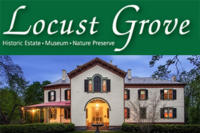by Shannon Butler
Have you ever been to Locust Grove, the home of Samuel F.B. Morse? If not, what are you waiting for? It’s right here in Poughkeepsie. Don’t know who Samuel Morse is? He is responsible for inventing the telegraph and the code that is used with it, known as Morse code. “Oh yeah, that guy!” you are probably thinking that you did know about him, but did you also know that Samuel Morse was a talented artist long before he was an inventor? It’s true, and you can go see his work for free with a museum pass thanks to your library card. But did you also know that long before the Morse family lived at this estate there was another older family that called this property home?
If you live in the Hudson Valley, you have certainly heard the family name of Livingston. That name is associated with at least a dozen large estates up and down the river’s edge and Locust Grove is one of them. This property originally belonged to Henry Livingston Sr. who served as the Dutchess County Clerk for 52 years (1737-1789) and also served in the Provincial Assembly (1759-1768). He owned several hundred acres just south of what is now the center of the City of Poughkeepsie. His son, Henry Jr. was born in October of 1748 on his father’s estate. He was clearly well educated as a young man as his writings have a classical feel and are what he would become famous for.
His penmanship won the heart of the woman he desired, Sarah, the daughter of Rev. Noah Welles from Stamford Conn. His letter to her in 1773 says it all, “I hope to see the girl for whom alone I would well bear to live. Yes, my dear creature, next Tuesday evening, if my God spares my life I hope to tell you I am sincerely your friend, as constantly your admirer, as religiously your lover as when I sat by your side and vow’d everlasting affection to you.” Just before the Revolutionary War got underway, Henry married Sarah and they moved onto a portion of his father’s estate (a nice size portion, about 260 acres).
Not long after they had their first child, the newly commissioned Major Henry Livingston was sent off to fight with the 3rd New York Continental Regiment. He ended up serving in Canada alongside General Richard Montgomery, the husband of his great-aunt Janet Livingston. After becoming ill, he traveled home to Poughkeepsie. For employment, he appears to have had various talents which served him well. He was a surveyor of land, a justice of the peace, and a farmer. He wrote beautiful poems, some of which show what life was like at Locust Grove in the late 18th century and just how much he preferred his country home to anything in the city.
“What is all the gay town can bestow?
What all its inhabitants share
But trifles and glitter and show
That cloy and displease as they glare.
By the side of a murmuring stream
Where willows the margin imbrown;
We’ll wander, unheeded, unseen,
Nor envy the taste of the town.”
Henry is also credited (by many, but not everyone) as being the author of the famous poem “Night before Christmas” also known as “A Visit from St. Nicholas.” His children (he had 12 of them between his first and second wife, Jane Patterson) and many of his grandchildren all claimed that they had heard him recite the poem before the claims that it was the work of Clement Moore started to appear in 1837. The poem first appeared anonymously in a newspaper in Troy NY in 1823. To this day there are still arguments to who the author really is. Henry Livingston died on February 29th 1828 and was buried on the Livingston land in a family burial plot, now part of the Poughkeepsie Rural Cemetery.
After Henry’s death in 1828, his property was sold to John and Isabella Montgomery from New York. They then sold the property to Samuel F.B. Morse in 1847. Morse married Henry Livingston’s great-granddaughter, Sarah Elizabeth Griswold and brought her to the property. Morse hired architect Alexander Jackson Davis to design the house just south of where the Livingston house stood (which actually continued to stand until about 1910). Davis designed for the Morse family a lovely Italianate style house in 1850 which was lived in by the family until William and Martha Young purchased the house at the turn of the 20th century.






